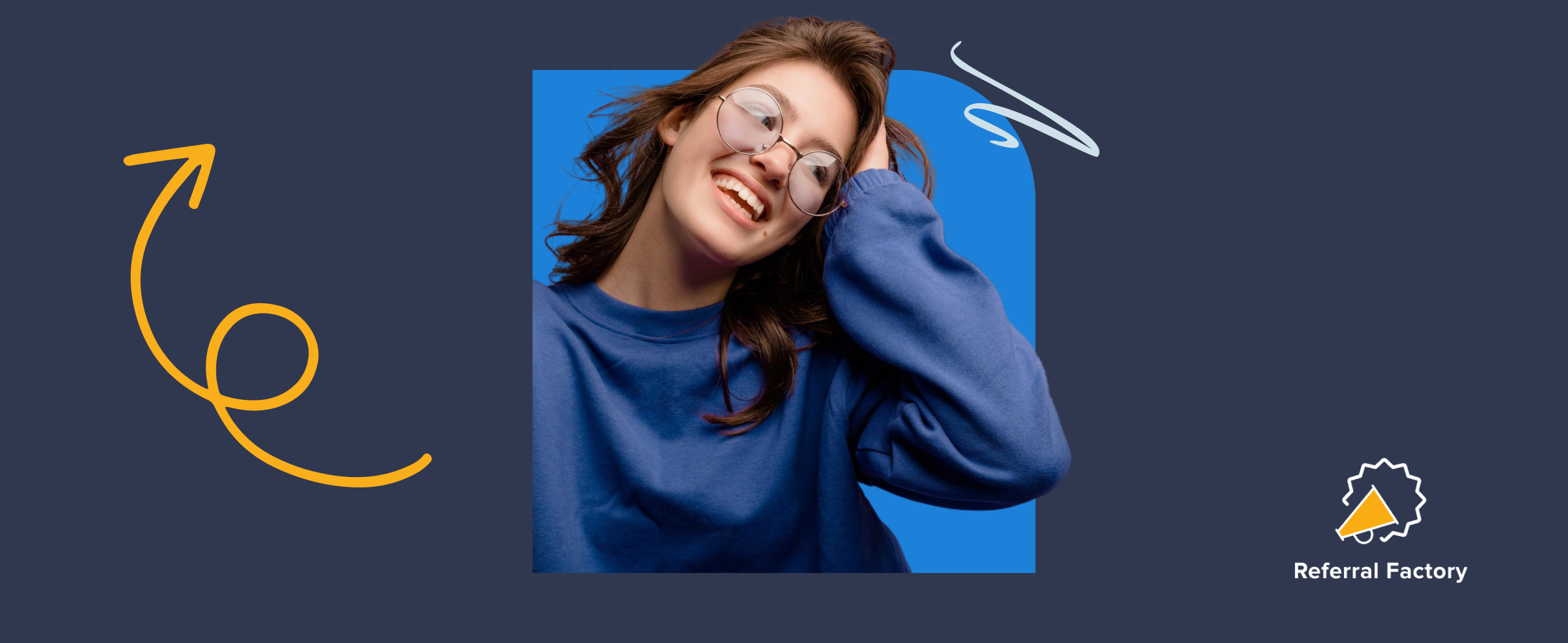A Simple Way to Track Influencer Marketing (Using A No-Code Referral Program)
Influencer marketing is more than just a trend; it’s a global takeover! Brands worldwide are hitching a ride on the social media influencer train to push their products and services to the forefront. But, if not managed efficiently, influencer tracking can be a drain on your time and resources.
Keeping on top of which influencers are bringing in leads and tracking lead conversion is a common challenge when it comes to influencer marketing. But don’t worry: there is a straightforward solution to that issue.
You can build an influencer program in just one click – enter your website below
Spoiler Alert! The solution isn’t one of those pricey influencer marketing platforms. Your best bet is actually to choose from one of the best all-rounder referral or affiliate marketing tools, which will allow you to easily manage and track your influencer marketing activities, affiliate performance and even customer referral program simultaneously. These tools do pretty much the same thing as an influencer marketing platform: find suitable creators, measure campaign performance, track sales and ROI, and analyze influencer activities and audience data.
Now, let’s see how this kind of referral software works and why it’s one of the most cost-efficient solutions out there. Or, if you’d prefer the crash course, watch this 👇
Table of Contents
Influencer Marketing Campaigns: How Do They Work?
Influencer marketing is easy to define: a brand teams up with someone popular online to promote its products to a particular group of people. Businesses might partner with content creators, experts, or social media folks with big followings to reach more users, get more attention, and connect with specific types of customers. Tracking and analyzing the performance of influencer partners is crucial for measuring campaign success and aggregating comprehensive data.
There are many types of influencer marketing campaigns. Let’s take a look at some of them:
🙌 Sponsored Posts
This is the most common approach, where influencers post about and promote products or services and get paid in return. The cool thing about these collaborations is that any brand, no matter how big or small, can use this strategy.
Even with one post, you can already get some engagement and data, especially if you’ve chosen an appropriate influencer.
🙌 Giveaways
These campaigns involve influencers offering their followers a chance to win a product or service. They generate buzz and excitement around the brand by increasing brand mentions across various platforms. By participating in the giveaway, followers may need to perform specific actions, such as following the brand or tagging friends, which helps increase brand visibility and engagement.
Watch out though, some participants may be more interested in the prize than your business. That’s why you might see a decrease in your metrics after the giveaway is over.
🙌 Brand Ambassador Programs
This method requires establishing a long-term relationship between the influencer and the brand. Brand ambassadors become advocates over an extended period. This kind of influencer campaign works well with only one or two well-selected partnerships and requires a slightly different approach when it comes to keeping track of brand growth.
🙌 Content Campaigns
These campaigns focus on creating compelling and engaging content that uniquely tells a story or showcases the brand. Influencer discovery tools and platforms can be utilized to find, filter, and analyze potential influencers for these campaigns. This could involve influencers creating videos, blog posts, or social media content that highlights the brand’s values, features, or benefits.
Whichever type of influencer campaign you follow, the crucial aspects to consider if how you will manage influencers effectively, and how best to streamline the process of finding, reaching out, and tracking influencer performance.
Case Study: Dunkin’ Donuts

These world-famous donuts are super popular on social media (of course). They have more than 3 million followers on TikTok. In one of their best influencer campaigns, they partnered with Charli D’Amelio.
The TikTok influencer, with 144.5 million followers, not only posed with Dunkin’ products but also whipped up her own content for their campaign.
The brand launched a campaign under the hashtag #CharliXDunkinContest and released a new beverage named “The Charli.”
Dunkin’ certainly aimed at virality: five lucky winners who recreated the video had the chance of a lifetime to hang out with Charli for a virtual Cold Brew date and drink the beverage named after her.
The impressions were powerful: the video had more than 200 million views, and the increase in the app download on launch day was 57%.
Is Influencer Marketing Really That Effective?
Well, after seeing the Dunkin’ Donuts example, it’s pretty clear – influencer marketing is more than just hype. Still, let’s look at some numbers, according to The State of Influencer Marketing 2024: Benchmark Report:
| ✅ By the end of 2023, influencer marketing has grown into a $21.1 billion industry, having increased by 29% from $16.4 billion in the previous year |
| ✅ TikTok (utilized by 56% of brands using influencer marketing) is now the most popular influencer marketing channel, beating Instagram (51%) for the first time and being ahead of Facebook (42%) and YouTube (38%) |
| ✅ Brands prefer working with small (nano – 39% and micro – 30%) influencers instead of partnering with expensive macro-influencers (19%) and celebrities (12%) |
| ✅ Influencers have a significant impact on customer loyalty (87%), awareness (89%), and reputation (87%) |

What Are the Downsides of Influencer Marketing?
So, now that we’ve established just how popular influencer marketing is, let’s just hold onto our horses. Before you start throwing money at internet celebrities and chasing brand collaborations, you have to know a few things about influencer marketing:
🤔 It can be extremely expensive. There are no clear regulations, and influencers often put crazy price tags for their services (because they can).
🤔 It’s not necessarily about size. That’s not just what she said! When it comes to local businesses catering to niche markets, such as florists or coffee shops, the size of an influencer’s audience is not the only measure of success. So, the most important factor you need to focus on is relevancy.
🤔 Finding the right influencers can be a challenge! Luckily, we’ve written a guide on how to find affiliates to promote your business, which has some handy tips that apply just as much to finding influencers.
Of all the downsides, here is the biggest: most brands and even influencer marketing agencies seriously struggle when it comes to influencer tracking and influencer search. And tracking your influencers’ performance will be critical to making sure they get paid fairly and you have full control over the ROI of your influencer campaign.
Sure, you can look at the likes or reposts on their social media, but you’ll need to dig way deeper to understand how well your influencer marketing is working, not just on your visibility but on your revenue. Otherwise, it is just like playing some game between guessing and hide-and-seek.
Influencer Tracking: What Do You Need to Know
To make influencer marketing truly efficient, brands must focus on tracking specific metrics, including media value. These include:
📈 Social media reach. The number of people who have seen the content shared by the influencer is a fundamental metric to gauge the campaign’s overall exposure.
📈 Engagement rate. By analyzing likes, comments, and shares, you’ll get insights into how well the audience interacts with the influencer’s content. However, this is just a glimpse into the level of engagement, which can also tell you if a particular influencer is a good fit for your brand.
📈 Sales or Conversions. This is beyond a doubt the most crucial metric. Why? Tracking revenue generated through your influencer campaign allows you to measure ROI. If you were to choose the only metric for tracking, that would definitely be this.
Great news: influencer tracking is simpler than you think! It is actually very easy to manage and see the actual results of the campaign. And, you don’t have to break the bank or get too techie to have a proper tracking system in place. Here is a very simple recipe: just invite each influencer to join your referral program. This is pretty much the gist.
Make sure your referral setup is ready for referral tracking to learn which of your incoming leads convert and turn into actual sales. That way, payments can be issued to the relevant influencer automatically. So, if you need such a tool (and for successful influencer marketing, you do), Referral Factory might be your best bet.
And being a flexible, plug-and-play referral software, it goes beyond simply checking the engagement rate, it gives you a full picture of your campaign. Plus, you can use it to manage affiliate and customer referral programs too!
Why Is Referral Software an Effective Influencer Tracking Tool?
So, why referral software? An influencer referral program is a savvy marketing strategy that leverages the reach of existing influencers to promote your brand. But! What plays the most vital role is the added ability to measure the sales they contribute through referrals.
You can precisely track the impact of each influencer by using a structured referral program facilitated by referral software. You can even use these tools to facilitate giveaways for new audiences.
How To Track Influencer Marketing Using Referral Software
Even though it’s simple to set up and understand, it’s worth getting deeper into how influencer tracking works using referral software so you can make the most of your efforts.
Referral software acts behind the scenes: it allows you to pinpoint the success of each referral made by bloggers, affiliates, influencers, or social media personalities. So, what do you have to do?
Create a unique referral link for each influencer. When the influencer promotes your brand, all they need to do is include their link and you’ll be able to effectively trace the journey of any leads all the way from a recommendation to a purchase.
Here’s an example of an influencer posting a referral link to Instagram:

Whenever a follower clicks on the and converts by making a purchase or something, it can be traced back to the influencer, who can then be issued with a commission or other reward.
Referral Factory does this tracking automatically by plugging into your CRM (like HubSpot, Salesforce, Monday, or Zoho) or payment gateway (like Stripe) in order to see whether the lead converts. It is as simple as it is efficient!
This way, you can also eliminate fake followers who have no real intention of interacting with your business. This method ensures transparency and accountability. In addition, it gives you valuable insights into the performance of each influencer in driving sales for your brand.
With referral software, you can track everything seamlessly and give rewards when they’re due. Just remember that you should understand the campaign objectives.
With this in mind, what are the best practices when it comes to tracking your influencer campaigns? Let’s take a closer look at some of your options:
Analyze Traffic Once You Launch an Influencer Campaign
When influencers talk about your website, they boost your reputation on Google. It’s not just about being famous; it’s actually about helping your site appear higher in Google’s search results. Plus, when people follow these mentions and visit your site, you get potential customers who are already interested.
Keep in mind that not every influencer’s mention will bring tons of sales, but they’re valuable pathways for more people to find out about your business. Sometimes, it takes time for the buzz being generated to convert into a measurable return.
To keep track of how many people are checking out your site and where they’re coming from, you can use Google Analytics, which you might need some help setting up, or track it right away from your no-code referral software. Additionally, a social listening tool can help monitor and track mentions, conversations, and influencers related to your brand in real-time.
Drive Conversion With a Special Offer for Followers
In influencer marketing, it’s crucial to recognize and reward influencers. But, don’t forget about the audiences they bring in. Make your rewards a win-win by offering incentives to their followers as well, especially when they make a purchase.
The options are numerous: free products, discounts, badges, and exclusive content. These personalized rewards make customers feel special and also motivate them to make that first purchase.
Ultimately, you create a strong connection between consumers and your business. After that, you can expect them to turn into your loyal customers or at least recommend your brand to someone else. In other words, this approach can expand your reach.
Give Coupon Codes and Use Them as Part of Your Influencer Tracking
Regardless of how many people an influencer reaches, they should bring customers back to your business.
Coupon codes are a way to do that. Here’s how it works. When a new lead registers on the influencer’s referral link, you give them a unique coupon code with a special offer. When people use these referral codes to make purchases, you can easily see and track those sales.
Plus, by making them register for a code, you get the lead even if they don’t convert! It’s a smart way to know which customers are coming from the influencer’s promotion, which helps you stay connected with them.

Why Is Referral Factory Your Best Choice for Influencer Tracking?
The best way to test a specific solution or a tool is to discover if it’s working for more than one goal. That’s the beauty of the Referral Factory: we create software that covers more than just influencers. You can track all types of referrals: customer referrals, affiliate referrals, employee referrals, ambassador referrals, and partner referrals.
Why is that important? Because you only need one tool to track and manage both your referral programs and influencer campaigns at the same time. Plus, it works for any niche, budget, or goal (and no coding involved). Sounds simple, right? No matter what your campaign objectives are, we can make sure you have the proper tools to achieve them.
That was always the main goal of our founder, Kirsty Sharman. She has a straightforward vision: a referral is a referral, no matter who’s giving it. That vision helped Kirsty create one of the biggest influencer marketing platforms in Africa over ten years ago.
Today, she believes that businesses should concentrate on getting more referrals because these leads are the highest quality you can get. And in your influencer relationships, referral software can play the role of a simple and highly effective tracking solution for future campaigns.
Influencer Marketing Analytics in Referral Factory
Referral Factory offers a comprehensive influencer marketing platform with an analytics dashboard that allows you to track your influencer campaigns and look at them from different angles.
For easier campaign management, you have three performance monitoring options:
- Campaign Performance
- Email Performance
- Your Referral Tree
Let’s take a closer look at each of them.
Using the Campaign Performance tab, you can monitor every single step of your referral or influencer program. In the dashboard, you will see the following metrics:
- Daily Users (influencers and new leads)
- Links Opens by Device (desktop, mobile, and tablet)
- Conversion Rate Of Your Referrals (i.e., how many leads actually fulfilled all the requirements of your campaign or made a purchase)
- Power Users (i.e., a leaderboard where you can see which influencers are the most active at bringing in new people, whether those are converted referrals or referrals that haven’t been converted yet).

By scrolling further down the analytics dashboard, you will see the following sections:
- User Breakdown By Reach (i.e., how many influencers share their links)
- Ratio Between Sources (including direct users, referred users, added users, Zapier users, and API users)
- Total Converted Referrals
- Where Users Are Sharing Their Referral Links (this metric might be beneficial for your influencer campaigns to understand which social media channels work best for your product/service).

If you go to the Email Performance tab, you can get all the necessary reporting on your newsletter campaigns. The options include:
- Bounce Rate
- AVG. Open Rate
- Total Emails Sent/Received/Bounced
- Email Sent Per Day
- Breakdown By Notification (i.e., by category of the email sent)

Finally, there is Your Referral Tree tab. This is especially helpful for visualizing your campaign management.
Influencer Tracking For Influencers
While it’s super important for you to track your influencer partners’ performance so you can manage your ROI and make sure the right influencer is getting paid for the right converted lead, it’s also vital to keep your influencers up-to-date with their metrics.
Luckily, Referral Factory provides tools to build custom tracking pages for your influencers where they can log in and see how they’re doing. In this logged-in dashboard, you can give them access to helpful content or brand assets, and let them track the following key metrics:
| 📊 The number of leads they’ve generated |
| 📊 The number of leads who’ve converted |
| 📊 Their conversion rate |
| 📊 Their performance compared to their peers |
| 📊 Their rewards and commissions |
Keeping your influencers well-informed is a great way to promote transparency and keep everyone on board! Here’s how you build tracking pages for your influencers in Referral Factory:

Conclusion
It doesn’t matter where your influencer posts their referral link: Instagram, Facebook, YouTube, or their personal blog. With referral tracking software, you have a perfect tool to analyze if your influencer program is working. Referral marketing is a great solution for proper influencer tracking if you want not only to monitor likes or shares but also evaluate the effectiveness of each influencer you work with.



